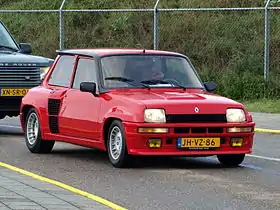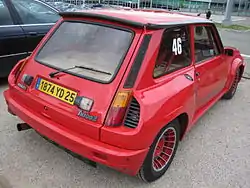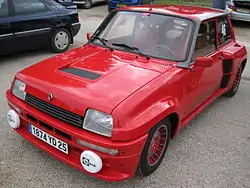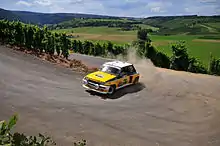Renault 5 Turbo
The Renault 5 Turbo or R5 Turbo is a sport hatchback automobile launched by the French manufacturer Renault at the Brussels Motor Show in January 1980. The car was primarily designed for rallying, but was also sold in a street version. A total of 4987 (turbo 1: 1820 and turbo 2: 3167) R5 Turbos were manufactured during a six-year production run.[1]
| Renault 5 Turbo | |
|---|---|
 | |
| Overview | |
| Manufacturer | Renault |
| Production | 1980-1984 (France) 1980-1986 (Belgium) |
| Assembly | Dieppe, France (Alpine) |
| Designer | Marcello Gandini at Bertone |
| Body and chassis | |
| Class | Sport compact |
| Body style | 3-door hatchback |
| Layout | RMR layout |
| Related | Renault 5 |
| Powertrain | |
| Engine |
|
| Transmission | 5-speed type 369 manual |
| Dimensions | |
| Wheelbase | 2,430 mm (95.7 in) |
| Length | 3,660 mm (144.1 in) |
| Width | 1,750 mm (68.9 in) |
| Height | 1,320 mm (52.0 in) |
| Curb weight | 970 kg (2,138 lb) |
| Chronology | |
| Successor | Renault Clio V6 Renault Sport |
Design
In response to Lancia's rallying success with the mid-engined Stratos, Renault's Jean Terramorsi, vice-president of production came up with the idea of creating a new sports version of the Renault 5 Alpine supermini.[2] The distinctive new rear bodywork was styled by Marc Deschamps at Bertone, headed by Chief Designer Marcello Gandini.[3] A Renault 5 Alpine was sent to Bertone in October 1977 to be used as a "mannequin."[2] The car's code name was Projet 822.[4]
Although the standard Renault 5 has a front-mounted engine, the 5 Turbo featured a mid-mounted 1,397 cc (1.4 L; 85.3 cu in) Cléon-Fonte with fuel fed by Bosch K-Jetronic fuel injection and a Garrett AiResearch T3 turbocharger OHV 2 valves per cylinder Inline-four engine placed behind the driver in mid-body in a modified Renault 5 chassis. In standard form, the engine developed 160 PS (158 hp; 118 kW) at 6000 rpm and maximum torque of 221 N⋅m (163 lb⋅ft) at 3250 rpm.[5]
Though it used a modified body from a standard Renault 5, and was badged a Renault 5, the mechanicals were radically different. The most obvious difference was the rear-wheel drive and rear-mid-engined instead of the normal version's front-wheel drive and front-mounted engine. The engineers creating the Turbo dug deep in the Renault parts bin in order to meet their goals: the rear suspension was derived from that of the rear-engined Renault Alpine A310 V6 while the five-speed manual transmission was the unit from the Renault 30 TX, rotated through 180 degrees. At the time of its launch it was the most powerful production French car.[6]
The original plan called for 1,000 cars to be built to meet the requirements for Group 3 homologation, with an eye to building an additional 3,000 cars for sale in the United States.[7] The first 400 production 5 Turbos were made to comply with Group 4 homologation to allow the car to compete in international rallies, and were manufactured at the Alpine factory in Dieppe. Many parts later transferred to the Alpine A310, such as the suspension or alloy wheel set.
Renault 5 Turbo 2


Once the homologation models were produced, a second version named Turbo 2 was introduced using more stock Renault 5 parts replacing many of the light alloy components in the original 5 Turbo version, and dropping the stunning and specific Bertone seats and dashboard for the interior of the R5 Alpine. Many parts also became dark grey rather than the iconic red or blue.[1] The Turbo 2 was less expensive, but had nearly the same levels of performance, with a top speed of 200 km/h (120 mph) and 0–100 km/h (62 mph) in 6.9 seconds.[8] To differentiate it from the Turbo 2, the original 5 Turbo is often referred as "Turbo 1".
The concept of a mid-engined small Renault returned with the 1998 announcement of the Renault Clio V6.[9]
Awards
In 2004, Sports Car International named the R5 Turbo number nine on the list of Top Sports Cars of the 1980s.
Motorsport
The R5 Turbo was conceived with dual intent, promoting the sales of the common R5 and being homologated in the FIA group 3 and 4 categories of the rally championship (today WRC). All the motorsport derivatives were based on the Turbo 1.
The factory pushed the engine output up to 180 PS (132 kW; 178 hp) for the Critérium des Cévennes, 210 PS (154 kW; 207 hp) for the Tour de Corse, and by 1984 as much as 350 PS (257 kW; 345 hp) in the R5 Maxi Turbo. The final Renault 5 Maxi Turbo Superproduction reached 385 PS (283 kW; 380 hp) and won the French Supertouring Championship that year.[10]
The Renault 5 Turbo competed in the sub-2000 cc category, thanks to the multiplication factor of 1.4 which was applied to turbocharged engines. FISA restricted tire and wheel sizes based on engine size, so for the Maxi Turbo, Renault enlarged to engine to 1527 cc which brought it up to 2138 cc in the eyes of the regulatory agencies - placing it in the 2000–2500 cc category and allowing for the fitment of wider wheels at the expense of a higher minimum weight.[10]
Driven by Jean Ragnotti in 1981, the 5 Turbo won the Monte Carlo Rally on its first outing in the World Rally Championship. The 2WD R5 Turbo soon faced the competition of new Group B four-wheel drive cars that proved faster on dirt. [11] [12]
WRC victories
There are several victories throughout the early 80's in the national championships in France, Portugal, Switzerland, Hungary, and Spain, many victories in international rallies throughout Europe, with wins in iconic rallies such as Monte Carlo. After the factory ceased support, it lived a second life being developed by many teams and enthusiasts to compete in regional championships and local races in which it was ubiquitous and reached many success for almost 20 years. [13] At the time of retirement, the newly created historical categories allowed these cars to return to international events and competitions, living a third life. For these reasons it has accessed to a legendary status and has a huge fan base. [14] [15]
| No. | Event | Season | Driver | Co-driver | Car |
|---|---|---|---|---|---|
| 1 | 1981 | Renault 5 Turbo | |||
| 2 | 1982 | Renault 5 Turbo | |||
| 3 | 1985 | Renault R5 Maxi Turbo | |||
| 4 | 1986 | Renault 5 Turbo | |||

References
- "Octane classic car specs". Classicandperformancecar.com. Archived from the original on 2011-10-05. Retrieved 2011-10-16.
- "Marc Deschamps disegna, Bertone Realizza" [Marc Deschamps designs, Bertone builds]. Renault5Turbo.it (in Italian). MR Electronics. Archived from the original on 2012-12-31.
- "''Evo magazine'' Birth of an icon: 1980, February 2008". Evo.co.uk. February 2008. Retrieved 2011-01-31.
- Pascal (1983), p. 8
- "1983 Renault 5 Turbo 2 specifications". carfolio.com. Retrieved June 14, 2018.
- Caven, James (1979-12-07). "French Flier". The Evening Times. Glasgow, Scotland. p. 42.
- Pascal (1983), p. 13
- Car Catalogue International 1983, page 79
- "Independent 17 October 1998". Independent.co.uk. 1998-10-17. Retrieved 2011-10-16.
- "La 5 Turbo da corsa" [The 5 Turbo competition models]. Renault5Turbo.it (in Italian). MR Electronics. Archived from the original on 2013-01-29.
- https://www.autoclassics.com/reviews/411106/ragnotti-drives-renault-5-turbo-1-sideways/
- https://www.evo.co.uk/renault/5/turbo
- https://www.renaultsport.com/-renault-5-maxi-turbo-1985-.html?d=1
- https://www.classicdriver.com/en/car/renault/r5-turbo/1980/202840
- https://www.sgs-engineering.com/help-advice/interview-renault-5-turbo-restoration-with-olly-melliard/
Further reading
External links
| Wikimedia Commons has media related to Renault 5 Turbo. |
- Renault 5 Turbo at the Internet Movie Cars Database
- Renault 5 Turbo 2 (in French, English, and Spanish), retrieved on 1 August 2008